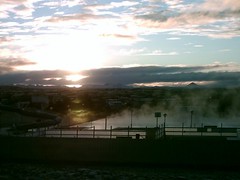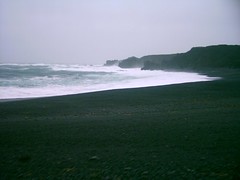Random self-publishing from Colin Roald
Because everyone needs a hobby
Archives : December 2005
2005 December 6
Subarctic sun
The sun takes a long time to rise in Iceland.
I arrived early Sunday morning off an overnight flight from Boston. The airport bus dropped me off downtown around 8. Everything was dark and quiet, the temperature was just below freezing, and there was a quarter inch of snow on the ground. I wanted to get something to drink, but no-one was around and nothing was open; even the main streets only had a few cars on them. It was hard to remind myself that it was not actually the middle of the night; it certainly felt like it, and by Boston time it was. Here, it was just Sunday.
The first thing, it seems, that opens in ReykjavÝk on a winter Sunday morning is Sundh÷llin, the public bath. A column of steam was rising from its upper deck; up there were outdoor hot tubs, and for about $4 I dumped my backpack in a locker, dug out my swimsuit, and watched the sky start to lighten. By 8:30 it had reached cobalt blue overhead and lemon cream on the eastern horizon.
By 9:30, stores were opening. I found a little grocery and got orange juice and yogourt (This seems to be a popular thing in Iceland. Even small groceries will have a whole cooler full of dozens of flavours and variations.) The sky was mostly light overhead and golden to the southeast, so I walked up the hill to HallgrÝmmskirkja to see if the sun was actually up. At 10 am, no, not yet. I spent fifteen minutes of eating breakfast on the snowy steps and the only perceptible change was perhaps it got a bit brighter.
Psychologically, this is strange. I have watched many sunrises and more sunsets in my life. In my head there is a model of how they're supposed to go. I did know that actual sunrise here wasn't supposed to be until 11, but ... it was clearly on the brink. I could see it ready to happen. At a deep level, this is disorienting, waiting for a sunrise that seems to hang in time. By its oldest conception, time is defined by the movement of the sun; when the sun fails to show up, you are in a time outside of time. The world is on pause. What happens in Golden Hour, stays in Golden Hour.
Official sunrise is at 11, but that doesn't mean you can see the sun yet -- there are hills on the southern horizon. By noon, I can finally see sunlight on the upper floors of buildings on the northern side of Austurv÷llur, the square in front of the Al■ing (Althing), the Icelandic Parliament. But even thought the open space is about a hundred metres square and the buildings around it are only three stories high, the sun is still so low on the horizon that its rays had yet to touch the ground.
Solar noon, its highest point, happens at 1:30. At this this time, it reaches a whole 3.3 degrees above the horizon. In practice, this is about a thumbwidth above the southern hills, sighted at the end of an outstretched arm. The sun continues to skim the hills rotating westward and the clock accelerates to make up the lost time and more. By 4 it is twilight again.
Yes, I'm in Iceland right now. I had a week of vacation time I had to take before New Years', and I guess I'm crazy enough to think that pre-Christmas festivities in ReykjavÝk would be cool. (And they are.) More later.
2005 December 8
Winter in Iceland
Guidebooks aren't much use in sorting out what's available in Iceland in the winter. Both the Rough Guide and the Lonely Planet treat anything from September to May as an afterthought; sometimes they give opening and closing dates for seasonal tourist services, but more often they don't say. Left unclear is whether you should assume silence means the thing is open all year or not. So I arrived in ReykjavÝk with a sketchy sort of idea of what to expect.
The off-season here is less dead than you might expect. Definitely go to the main tourist information office in downtown Reykjavik, the one on AalstrŠti near the Parliament. In addition to catalogs of open services, they have an array of excellent maps. (In particular, get the "Big Map" of ReykjavÝk, the "Magical Iceland" map of SnŠfellsnes, and the "Power and Purity" map of South Iceland. You may have to hunt for them on the racks, but they're worth it. I've never seen free tourist maps with topo lines before.)
Most hotels are open, many guesthouses, not many hostels. Most places you could stay in the summer, if you can get to it at all, there's still an accomodation option. Winter rates are often cheaper. (And probably regardless of season, BB44 is an excellent ReykjavÝk-area guesthouse if you don't mind being a little ways out in the suburbs.)
This is particularly true of rental cars. The best deal I found for my car was through the main ReykjavÝk tourist office from an Icelandic company, Berg, and it was a third of what it would have been in the summertime (and less than anything I could find online). On the downside, to get around, you're pretty much going to have to rent a car. Only a few guided tours are still running, and bus service has been cut back. Buses still go to Borgarnes and Akureyri. There's one bus a day to Stykkisholmur, and none anywhere else on SnŠfellsnes. No service at all to Reykholt, ١rsm÷rk, or Landmannalaugur.
١rsm÷rk and Landmannalaugur in fact are pretty much inaccessible, period. The roads are categorized "closed" by Vegagerin, the Icelandic Public Roads Administration. I'm not sure in practice what would happen if you attempted to drive them -- my impression is that they are physically impassable short of mounting a full-on expedition, $200+/day vehicles, experienced offroad drivers, no fooling around. (The road to ١rsm÷rk, I'm told, requires crossing several unbridged rivers.) But you don't have to take my word for what's probably open. Vegagerin publishes an excellent daily road report with a colour-coded map of every significant road on the island.
Be extremely careful of the roads even if they're supposedly open. Icelandic roads often have very soft or no shoulders, no guard rails, and steep drops. Small side roads may be unplowed and/or much icier than the main roads. In North America, roads that aren't being maintained for winter are normally posted closed and chained off; Iceland is more Darwinian.
The climate here is maritime, which means December temperatures cycling above and below freezing, a lot of moisture in the air, and high winds. When I arrived the weather was frosty and mostly clear. Today was stormy with gusts to gale force (45 mph) and intermittent rain. As far as I can tell, neither is unusual for Iceland in December. I'm told ReykjavÝk doesn't usually see much real snow until January. But with a wool sweater, a couple layers of shirts, and a good rainproof jacket, the weather is survivable. Today I got in a good couple hours of hiking at SnŠfellsnes, climbing to the rim of the volcanic crater Rauhˇll and the waterfall Klukkufoss(*) during a lull in the rain, but getting drenched with horizontal sleet at Dj˙palˇnssandur(**). It was still great to be out there; I pretty much had a whole national park to myself.
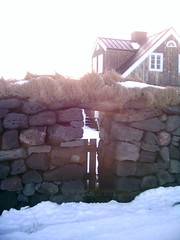
(*) Rauhˇll and Klukkufoss: Take route 574 west from OlafsvÝk and Hellissandur. West of Hellissandur this is a gravel road. Look for the signed intersection for Índverarnes and follow the main (left) branch 4 km south to an unsigned intersection on your left. I parked my car here, even though the gravel track up the mountain would have been completely passable even with a subcompact -- traffic on 574 was hardly more than a few cars an hour, and I figured none on the mountain road, and if something happened to me I wanted my car to be found. Twenty minutes walk in along the side road on soft sandy gravel there is a small sign for Rauhˇll to your right. The dead cone and its crater are completely obvious from the road, but the small river MoulŠkur is in the way. The track up Rauhˇll is little more than a footbridge, some flattened grass, and a line of orange-painted stakes marking a clear line through the lava field. Today was mostly bare grass and bracken with just occasional snow patches and the trail was easy to find -- if you arrived in snowy weather you might be out of luck. (Mostly it wouldn't matter where you walked, except there are occasional deep, inconspicuous sinkholes and fissures. Note the one marked Eysteinsholar by the side of the road on your walk in.) I walked a loop around the rim of the crater and then back to the road and farther up toward SnŠfellsj÷kull. Another ten minutes on there is another sign to your right for Klukkufoss. This trail also is mostly just a line of stakes, but it is steeper, wetter, and rougher. In frozen conditions, you'd probably be well advised not to try it without an ice axe. It leads uphill to where the MoulŠkur plunges into a black basalt gorge, a lovely, wild place, with a good view over the whole northwestern corner of the peninsula. The path I believe actually continues to the top of the mountain, but the snow was thicker up there and I didn't push my luck. This was all about two hours walk, and I didn't see a single other soul, or even fresh footprints other than my own.
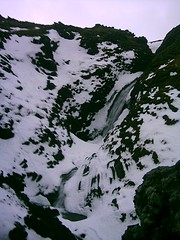
(**) Continuing farther to the south on 574, there is a signed turn-off to the right for Dj˙palˇnssandur. I broke my rule about keeping the car on the main road because (a) the weather had turned vicious and I didn't want to hike any more; and (b) inexplicably, the side road to the beach was paved and in better condition than the "main" road. I think in fact it was the perfect day to visit that beach, though. The winds were gale force (and I mean that precisely -- gusts to Beaufort Force 8, "generally impedes progress"), and the surf rolling in was ferocious. It was a monochrome world: black gravelly beach, white surf, grey skies, black cliffs; except for twisted rust-red pieces of scrap metal strewn across the depth of the beach. These were, according to a sign, the remains of a British trawler that had been torn apart in a storm off the beach in 1948. The gale I was standing in didn't count as a real storm; this was just bad weather.
2005 December 18
Pictures of Ice and Fire
I have uploaded pictures to Flickr.
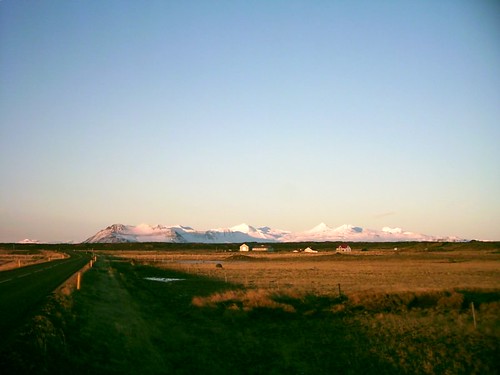
(I have one more essay to post about the trip; it's half written, and I swear I will not let it fade away unfinished.)
Update: Also, Maciej Ceglowski of Idle Words was recently in Iceland.
2005 December 30
Hurry hard
So, curling. That other, shameful Canadian winter sport. The one that is not talked about in front of outsiders; the one played behind closed doors in private, nigh-Masonic clubs in every small town in the Frozen North. The game with the sweeping. That one.
It turns out there's a club in Wayland. I joined up and have been playing again this year, for the first time since high school. I'd forgotten how much fun it is -- for me, it's about the perfect combination of whole-body skill, balance, bursts of frenetic activity, team coordination, analytical tactics, and beer (I am not aware of a curling club in the world that does not have its own bar in the building). It's a social activity; it offers hardly any meaningful advantages to gender -- nobody bothers to count how many women are on a coed team -- and it's a sport with traditions of gentlemanly conduct regarded as having equal standing with the rules of the game.
The structure of the game is comparable to bocce or boules -- you score by throwing closer to the button than your opponents, but in this case you're sliding 45-lb polished granite stones across 120' of ice. Delivery of a stone is a graceful, whole-body sliding motion that, done well, can easily cover 30 feet before you release the rock, and after that your teammates will follow the rock up the ice. By polishing the ice in front of the sliding rock -- this is where the brooms and the teamwork come in -- good sweeping can carry an imperfect throw as much as 10 feet farther than it would otherwise have travelled.
You wear a slider made of actual teflon under one foot, to skim faster over the ice.
It's surprisingly addictive.
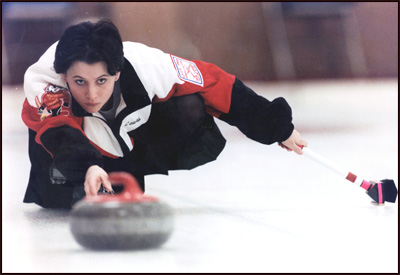
This brings me to: it's coming up on midseason, and registration is open again for the second half. Before that, the club is having an open house on Sunday (yes, New Year's Day). There will be lots of friendly people and probably hot chocolate and fresh cookies and complimentary beer (I'm not kidding). But frankly, that's not the way you want to try the game -- if the fall open house is anything to go by, you'll get hardly any ice time, and almost no opportunity to actually throw rocks. I suggest you come with me. There's open ice tomorrow afternoon and Sunday evening and Monday.
Anyone interested in giving it a try?
2005 December 31
Heitur pottur
There are really only two things in Iceland that are better in the winter than in the summer. One is the chance to see the Northern Lights, which obviously can't be combined with midnight sun. But 2005 is pretty much solar minimum -- that is, the quietest point of its ~11-year activity cycle -- so my odds were poor to begin with, and in any case cloudy December would still be the wrong month to pick for a trip to see aurorae. (My advice: wait until 2009 or 2010 and go someplace continental: perhaps Whitehorse or Yellowknife.)
That leaves the real reason to go to Iceland in the winter: the hot pools.
Iceland is a strange place. Geologically, it's a brand new land. It's the froth on the crest of a magma fountain, an exceptionally large mantle plume; simultaneously it is being torn raggedly in two on the fracture line between the European and American plates. Probably it is the most volcanic place on earth.
So hot water is pretty much free. You drill a well almost anywhere, pump cold water down, and it comes up boiling. In ReykjavÝk, it's a city utility: you connect up to both cold and hot water mains, and get it at 80 C (175 F) out of the taps. It smells rather sulfurous and will tarnish silver jewelry, but in a place where cheap hamburgers cost $15, I don't know if they even meter the hot water.
How cheap is it? Commercial farming operations grow vegetables in winter in greenhouses kept warm with geothermal steam. You drive into the valley at Hverageri and are met with clouds of warm fog glowing bright orange from the grow lights. They don't bother shuttering the glass -- insulation is more expensive than the heat. (Electricity is cheap, too. There are lots of places where you can get steam out of the ground hot enough to run straight in to a turbine. If they could think of more things to do with the electricity, they could generate a lot more of it. They already import aluminum ore from Australia for smelting.)
ReykjavÝk pipes warm water under city streets to keep them from freezing.
My guesthouse had a hot tub in the back. I don't know if they even had an insulating cover for it; as far as I could tell, they kept it warm all the time, uncovered in December, just by letting the water run.
It is so plentiful that ReykjavÝk creates for itself a warm-water beach by pouring millions of gallons of it into an artificial lagoon on the shores of the Greenland Sea. They call the place NauthˇlsvÝk Geothermal Beach, and it amounts to a city-sized hot tub. I was asking a guy in a bar about it, and he declared it the worst beach in the world: the sun is not hot enough, and the black volcanic sand is coarse. But he also said that on nice weekends the place is packed; I am unpersuaded that any place full of Icelandic girls in bikinis could be that bad.
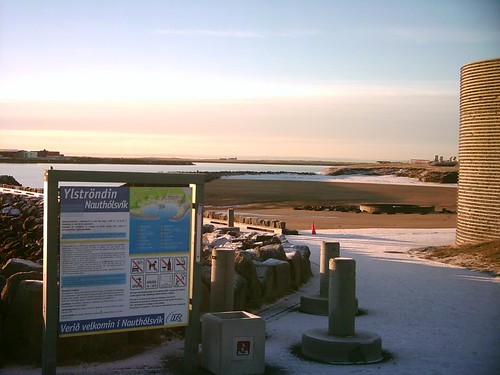
Sadly, not even Icelanders are crazy enough to keep their beach open in December.
Every town in Iceland has a year-round outdoor swimming pool kept heated to 27 C (80 F). ReykjavÝk has seven of them, and the city is only 120,000 people. On a cold day, great clouds tower into the sky above the city, marking not power plants, but the locations of the city pools. They all have, in addition to the regular Olympic-sized swimming pool, a series of "hot pots", heitur pottur, containing water at a range of temperatures from soothing to searing.
Where other people would use cafes or pubs, Icelanders hang out and socialize in the hot tubs; they stay open until 9 or 10 at night. I was told that people would meet at the pool for office birthday parties and such. One I was in burst into Icelandic Christmas carolling; I was left awkwardly unable to join in.
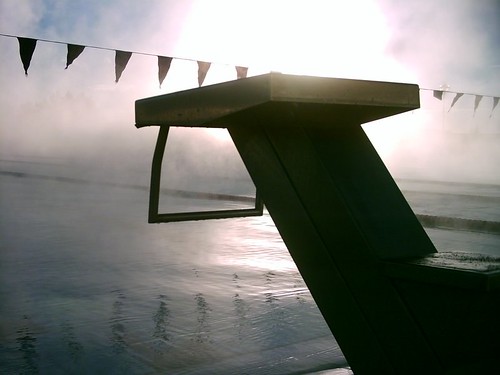
The facilities are impressive. Sometimes there are shallow kiddie pools, or water slides, or steam rooms, sun lamps and spa facilities. Laugardalslaug is an athletic complex with stadium seating. ┴rbŠjarlaug has hiking trails. My favourite, Sundh÷llin, is an old-school downtown public bath hall where you rent towels from an attendant and get your own private locking changing booth. There are rows of these booths, filling the changing area like pigeon holes. The dividing walls and benches, everything but the wooden partition doors, are permanent construction, tiled in elegant seafoam green. You enter your changing room from one side and leave into the shower area through the other; the arrangement of halls is like nothing so much as arteries and veins.
Icelanders are conservative about wearing bathing suits in hot tubs, but strict about showering naked before entering. They use no chlorine in the pools, I presume because they constantly refresh the water with new from the hot mains, and so every pool shower room has large signs from the Board of Health announcing "ATHUGIđ! ATTENTION! ACHTUNG!" in six languages. There is a large outline of a person with the naughty bits helpfully highlighted and red arrows indicating that soap is to be applied. Shampoo is provided from sturdy gallon-sized pump dispensers on the walls.
At Sundh÷llin, the pool is in a hall indoors. When I was there, no one was using it. Everyone had gone upstairs and outside to the third-floor balcony for hot pots and a sauna, swirling steam, and a view over the roofs around us. I sank into the water and watched the mid-morning, pre-dawn sky slowly changing colours to the east.
I have also uploaded some new pictures from the trip, taken by Amy. Finally, this includes a picture of the 60-m Skogarfoss waterfall, and even one with me in it.
![[go to main index]](/notes/images/woodcut-sun-grey.jpg)

